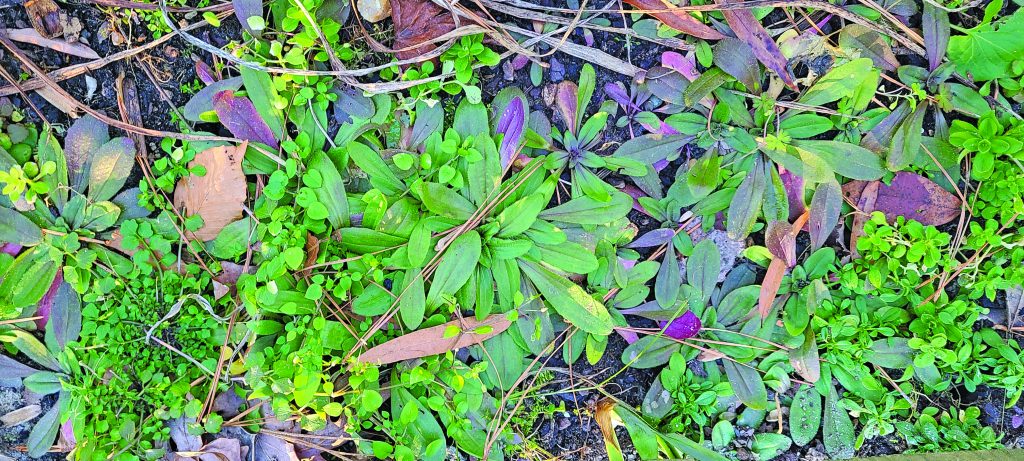Last Friday was a perfect day to spend some time outdoors. Bright sunshine in an almost cloudless blue sky, and a mild temperature around 60° lured me outside to take stock of winter happenings in the front garden.
Daffodils are up about 3 to 4 inches in some sheltered spots. The two gardenia bushes look healthy, without signs of winter damage. Tiny, pink buds have appeared at the tips of the Clethra branches, and Jim noticed a few green leaves unfurling on the elderberry bushes. All of this new growth could freeze within 24 hours with a severe drop in temperature or a sudden snowstorm. The daffodils would survive a spate of harsh weather, but new growth on the other plants likely would not live.
Last fall, we removed some spent perennials from the beds and potted extras to re-plant in the spring. Several species of broadleaf winter weeds have set up housekeeping in the vacated spaces. I didn’t pay much attention to them, because they were green, but I realized on Friday that they had spread more than I had realized, so it was time to start removing them.
Broadleaf winter weeds can be either annuals or perennials. Winter annual weeds germinate during the winter and bloom in February, March, and April. They die after producing seeds between spring and autumn, depending on the species. I have written about henbit and purple dead nettle, two winter annual weeds that bloom in our field each spring. I didn’t find them in the flowerbeds last week.
Instead, I discovered large patches of common chickweed (Stellaria media) growing in empty spaces and under fallen leaves and debris. Native to Europe and Asia, it grows all over the world. Chickweed is a pretty, mat-forming plant with egg-shaped, bright green leaves. Tiny, white, star-shaped flowers bloom in spring. Chickweed reproduces by seed and creeping stems.
Winter perennial weeds live indefinitely, although they may have dormant periods. Perennial mouse-ear chickweed (Cerastium vulgatum) is similar in appearance to common chickweed, but it has fuzzy leaves that resemble mouse ears. It reproduces by seed and by creeping stems that root at the nodes.
Broadleaf plantain (Plantago major) and buckhorn, or narrow-leaf plantain (Plantago lanceolata), are perennial broadleaf winter weeds that reproduce from seeds. Both species produce a ground level rosette of bright green leaves. Broadleaf plantain leaves are egg-shaped and 1½ to 7 inches long. In summer, broadleaf plantain produces white flowers along a leafless 2 to 18 inch-long stalk. Buckhorn plantain leaves are narrow and lance-shaped, from 2 to 10 inches long. They may be curled or twisted. The cone-shaped spike of white flowers grows on a leafless stalk.
Common cinquefoil (Potentilla simplex) also is a perennial broadleaf weed. It is only 4 to 5 inches tall with rough, hairy, prostrate stems that root at the nodes. Each leaf has five leaflets with toothed margins. The yellow flowers are five-petaled.
Most of these weeds are easy to remove by hand, especially if the ground is damp. The best time to remove them is in late summer or early fall before they germinate. Clean your tools after weeding to prevent transferring tiny seeds to other parts of the garden. Dispose of garden debris by bagging or burning. Don’t put weeds in the compost bin, where seeds can sprout. Buy compost, mulch, and grass seed that are labeled “weed-free.”
Several excellent weed identification websites are available online. The University of Maryland Extension Home & Garden Information Center and the North Carolina State Extension Gardener Plant Toolbox websites contain photo galleries of weeds commonly found in our region, as does the Clemson University Extension and the Missouri Botanical Garden Plant Finder. Plant ID apps allow you to snap a photo of a weed with your smartphone for immediate identification. The percentage of accuracy varies from app to app, and some sites charge a fee, so it pays to investigate before you download.

